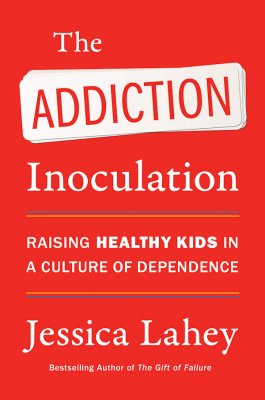
Substance abuse prevention in children and teens requires much more attention and discussion among parents. Instead of anxiously waiting to see what addictions may befall children in their teen years or magical thinking that “it won’t happen to my child,” experts know a lot about who gets addicted and why.
Research shows that substance abuse prevention is possible with the right knowledge, expectations, and practices.
Jessica Lahey is an alcoholic. She is also an educator, mother, and the New York Times best-selling author of The Gift of Failure.
 Lahey’s most recent book, The Addiction Inoculation: Raising Healthy Kids in a Culture of Dependence, provides a comprehensive, well-researched, and intimate account of how substance abuse is often preventable and why “Just Say No” does not work.
Lahey’s most recent book, The Addiction Inoculation: Raising Healthy Kids in a Culture of Dependence, provides a comprehensive, well-researched, and intimate account of how substance abuse is often preventable and why “Just Say No” does not work.
“All children, regardless of their genetics,” says Lahey, “are at some risk of substance abuse.”
The Partnership to End Addiction states that adolescent substance use is the largest preventable health problem in America today. Instead of avoiding the topic, Lahey leans into it with conviction and authenticity. She hopes parents will take her lead.
Substance Abuse Prevention Begins with Families
According to Lahey, “every substance abuse story begins at home.” Family is the most important influence on the well-being of children. It is also the most important risk factor. For example, children that grow up with addicted parents are genetically and emotionally primed to follow in their footsteps. But the roots of substance abuse are varied. Adverse childhood experiences, including bullying and sexual harassment, account for more than sixty percent of binge drinking in twelve- to eighteen-year-olds.
Toxic stress is another root cause of substance abuse in teenagers. The American Psychological Association reports that young people ages 13-17 are facing unprecedented uncertainty and stress. Surveys found that the pandemic has caused a new wave of mental and physical health consequences, including unhealthy weight gains and increased drinking.
Despite the research and known causes of substance abuse, parents still find it difficult to talk with their children about drugs and alcohol. Why?
According to Lahey, “There is a balance to be struck in parenting for substance abuse prevention: parents want as much information and reassurance as we can get our hands on, but our children want (and need) autonomy, privacy, and to feel trusted.” It is a tough balancing act.
Does Your Parenting Style Matter?
In 1991, psychologist Diana Baumrind authored an article in The Journal of Early Adolescence that explored how parenting styles affected child development, especially substance abuse prevention. A major limitation of her research was that it included predominately affluent, well-educated, Caucasian families. In the thirty years since, researchers have explored the effects of multi-cultural parenting styles on healthy development. A much-debated topic, there are some points of agreement, explained in more detail later.
Lahey simplifies the debate in her book, delving into the authoritative parenting style (high warmth and high behavioral control) and how it supports substance abuse prevention. She outlines the central behaviors of this parenting style to include:
- Holding high expectations for a child’s conduct
- Providing reasoning behind expectations
- Enforcing expectations fairly
- Being warm and supportive
- Encouraging children through failures and mistakes
- Prioritizing child’s learning vs obedience
- Giving children autonomy and room to grow
- Recognizing a child’s interests and goals
- Validating that a child is worthy of love and respect
Lahey’s list reinforces what the fields of positive youth development and positive parenting recommend—to focus on practices that nurture the development of a child’s internal strengths, like resilience, self-awareness, and resourcefulness. When children believe in themselves and their abilities, research shows they do better in school and are less likely to develop problems with substance abuse and other addictions.
Back to the debate on parenting styles: While positive parenting practices are important to adopt as part of your parenting toolbox, researchers most agree on the parenting styles that can cause children to become addicted to alcohol or drugs.
Published in the journal Developmental Psychology in 2017, a meta-analysis of 1435 studies compared parenting styles with externalizing problems of children and adolescents, including substance abuse prevention. This analysis concluded that the following parenting styles were highly correlated with problems related to addiction and other mental health disorders in children.
- Harsh control – This style involves physical or verbal punishment and intrusiveness.
- Psychological control – This style attempts to manipulate a child’s psychological experiences by using guilt, shaming, and conditional love.
- Authoritarian – This style involves low warmth and high/harsh control vs. the authoritative style described by Lahey that involves high warmth and high behavioral control.
- Permissive – This style involves high warmth and low control.
- Neglectful – This style involves low warmth and low control.
As Lahey suggests, parenting for substance abuse prevention is a balancing act. Most parents do not use one “style” of parenting at all times. Reactions and practices vary depending on the situation, age of child, and a parent’s own well-being. The most important learning from research is to pay attention to parenting behaviors that are most correlated with childhood problems like drug or alcohol addiction.
If you frequently use the above “harsher” or “permissive” styles in your parent-child relationship, stop. Find resources that will help you understand ways to positively impact your child’s healthy development.
Related Articles You May Enjoy
Resilience: How Families Grow from Adversity
Self-Awareness: How Parents Foster Meaning and Purpose in Kids
Resourcefulness: How Parents Help Children Achieve Goals
References
Baumrind, D. (1991). The Influence of Parenting Style on Adolescent Competence and Substance Use. The Journal of Early Adolescence, 11(1), 56–95. https://doi.org/10.1177/0272431691111004
Pinquart, M. (2017). Associations of parenting dimensions and styles with externalizing problems of children and adolescents: An updated meta-analysis. Developmental Psychology, 53(5), 873-932.
Published: April 7, 2021



